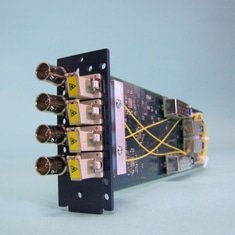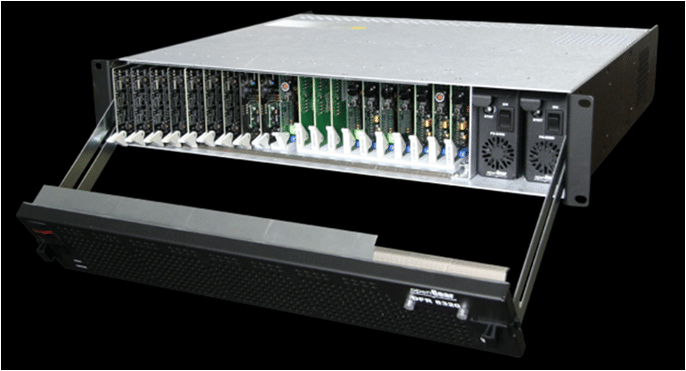From 1 to 18 signals per fiber and built-in cross-points, the VidOptic FVT/FVR-5000 Series makes your SDI signal transport and distribution SIMPLE!
- Encodes Digital (SDI) and Analog (Composite) Sources

- Dual Inputs Allow Two Separate or Simulcast Channels
- High Performance Real Time MPEG-4 AVC Output
- Open Architecture, Non-Proprietary Codec Allows for Numerous No/Low Cost Viewer Options
- Resolution: 320×180 through 1080p/60 (add’l license(s) req’d for HD)
- Unicast and Multicast
- DVB-ASI and IP Outputs
- Audio: Embedded SDI, Unbalanced Analog & Dolby Digital AC-3 Pass Through
- Fits openGear™ Chassis
OVERVIEW
The new VidOavtion VidOptic FVT-5400-3G series of modules for the openGear platform provides unprecedented flexibility in how you handle your SDI signal transport. Capable of handling SDI rates from
5 Mb/sec all the way up to 3 Gb/sec uncompressed, these cards will automatically detect the incoming signal and give you full control over re-clocking and routing.
The table, below, shows the 5 different card sets available in the FVT-5400-3G line. With each module you get the same control features that are available both on the front card edge (via dip switches) or through the openGear Dash-Board software.
But the true power of the 5400-Series is the ability to daisy chain up to five cards to create an 18-Channel CWDM mux that is ideal for high-density signal trunking.
The FVT-5400’s also incorporate an integrated cross-point matrix that allows not only the ability to assign a given input signal to one or more outputs, but also to enable and disable outputs should the need arise. There’s also an automatic fail-over mode that, when selected, will switch to another input should the signal in the first input somehow fail. Embedded audio is fully supported. All outputs are non-inverting and ASI capable.
The VidOptic FVT-5400-3G’s. The cost effective way to move all of your HD signals along with the convenience of a built-in switcher, remote monitoring and automatic fail-over protection switching.
1,2,3 or 4 Signals Per Card
We know that one size never fits all and signal transport is no exception. Whatever your signal count, our cards can be easily combined to match your requirement. In cases where signals are being optically multiplexed with a CWDM, we mount the CWDM filter directly on the card so that you don’t need to waste valuable slots in your frame. And the cards are automatically detected by the Dashboard software so there is no need to set DIP switches to indicate how many signals are present on a given card. A fully populated frame with 4-channel cards will give you 40 signals in just 2 RU.
Built-in Cross Point
It is one thing to move HD signals over fiber but it is really nice to be able to route a given input to one or all of the outputs. Our built-in cross point gives you unprecedented control over your signal flow by allowing you to simply route signals or to turn them off entirely…all from the Dashboard or via the front-edge DIP switches. If you suddenly need an HD video DA, simply route one input to all 4 outputs of the card. It’s that simple.
Protection Switching
Once we had the cross point, providing a protection switching scheme was an easy decision. So, not only can you route your signals through the frame, you can also assign a secondary input should the primary input fail. Once the card detects that the HD carrier has gone, it quickly switches over to the assigned back-up signal. These parameters can be configured through the DIP switches as well as through the Dashboard interface.
Total Control of your I/O
We understand the importance of being able to efficiently move and route HD signals throughout your facility. The HD-4000 Series provides the feature set to accomplish this while also providing the tools to enable you to recover from a signal failure or to quickly respond to changing signal needs.
Dashboard Monitoring and Control
Of course, the best way to keep watch over your signals is to have access to a state-of-heart monitoring platform like DashBoard. Once a card is inserted into an openGear frame, it is remotely monitorable through Dashboard. With the basic frame (-C) a single user can monitor at a time. With the -CN frame, multiple users can work simultaneously. And with the -CMS frame, your are SNMP enabled to integrate into your larger monitoring environment. All of the essential card and signal parameters can be seen and manipulated in an easy-to-use graphical interface including re-clocking on/off, laser status, temperatures, input/output signal status, alarms and more.
The Dashboard software is free and you can download it at www.opengear.tv.




Ordering Information:
| Product | Description |
| FVT-5400-3G | 4 Ch. 3.0 Gbps Multi-rate HD-SDI TX over 4 fibers, supports 5 – 2970 Mb/s, EQ & Reclocker; 1310nm Singlemode, -2 dBm |
| FVR-5400-3G | 4 Ch. 3.0 Gbps Multi-rate HD-SDI RX over 4 fibers supports 5 – 2970 Mb/s, EQ & Reclocker; 1310nm Singlemode, -20 dBm Sensitivity |
| FVT-5400-3G-CWDM | 4 Ch. 3.0 Gbps Multi-rate HD-SDI TX over 1 fiber, supports 5 – 2970 Mb/s, EQ & Reclocker; CWDM, Singlemode, -2 dBm |
| FVR-5400-3G-CWDM | 4 Ch. 3.0 Gbps Multi-rate HD-SDI RX over 1 fiber, supports 5 – 2970 Mb/s, EQ & Reclocker; CWDM, Singlemode, -20 dBm Sensitivity |
|
Made in the USA. |


